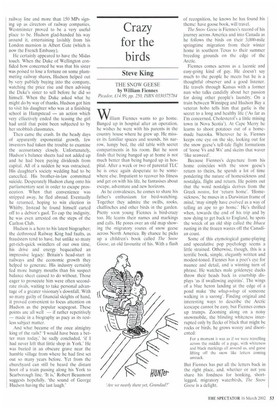Crazy for the birds
Steve King
THE SNOW GEESE by William Fiennes Picador, £14.99, pp. 250, ISBN 0330375784
William Fiennes wants to go home. Banged up in hospital after an operation, he wishes he were with his parents in the country house where he grew up. He misses its familiar spaces and sounds, his narrow, lumpy bed, the old table with secret compartments in his room. But he soon finds that being banged up at home is not much better than being banged up in hospital. After a week or two of parental TLC he is once again desperate to be somewhere else. Impatient to recover his fitness and get on with his life, he fantasises about escape, adventure and new horizons.
As he convalesces, he comes to share his father's enthusiasm for bird-watching. Together they admire the swifts, rooks, chaffinches and other birds in the garden. Pretty soon young Fiennes is bird-crazy too. He learns their names and markings and calls. He pores over an old map showing the migratory routes of snow geese across North America. By chance he picks up a children's book called The Snow Goose, an old favourite of his. With a flash
of recognition, he knows he has found his theme: have goose book, will travel.
The Snow Geese is Fiennes's record of his journey across America and into Canada as he follows the birds on their 3,000-mile springtime migration from their winter home in southern Texas to their summer breeding grounds on the edge of the Arctic.
Fiennes comes across as a laconic and easy-going kind of guy. He doesn't say much to the people he meets but he is a thoughtful observer and a good listener. He travels through Kansas with a former nun who talks candidly about her passion for doing other people's laundry. On a train between Winnipeg and Hudson Bay a veteran hobo tells him that garlic is the secret to a long and healthy life (As far as I'm concerned, Cholesterol's a little mining town in Nova Scotia'). At Cape Merry he learns to shoot potatoes out of a homemade bazooka. Wherever he is. Fiennes keeps one eye on the sky, looking out for the snow geese's tell-tale flight formations of 'loose Vs and Ws' and skeins that waver 'like seaweed'.
Because Fiennes's departure from his home coincides with the snow geese's return to theirs, he spends a lot of time pondering the nature of homesickness and nostalgia, flight and return. He points out that the word nostalgia derives from the Greek nostos, for 'return home. 'Homesickness,' he muses in a Darwinian frame of mind, may simply have evolved as a way of telling an ape to go home.' He's thrilled when, towards the end of his trip and by now dying to get back to England, he spots the wreck of an old ship called the Ithaca rusting in the frozen wastes off the Canadian coast.
Some of this etymological game-playing and speculative pop psychology seems a little strained. Otherwise, though, this is a terrific book, simple, elegantly written and modest-toned. Fiennes has a poet's eye for nuance and detail, and a winning turn of phrase. He watches male goldeneye ducks throw their heads back in courtship displays 'as if swallowing aspirins'. The wings of a blue heron landing at the edge of a pond make 'the whup-whup of someone walking in a sarong'. Finding original and interesting ways to describe the Arctic icescape cannot be easy, but Fiennes comes up trumps. Zooming along on a noisy snowmobile, the blinding whiteness interrupted only by flecks of black that might be rocks or birds, he grows woozy and disoriented:
For a moment it was as if we were travelling across the middle of a page, with whiteness and black markings all around us, and geese lifting off the snow like letters coming unstuck.
But Fiennes has put all the letters back in the right place, and, whether or not you share his fondness for honking, shortlegged, migratory waterbirds, The Snow Geese is a delight.
















































































 Previous page
Previous page